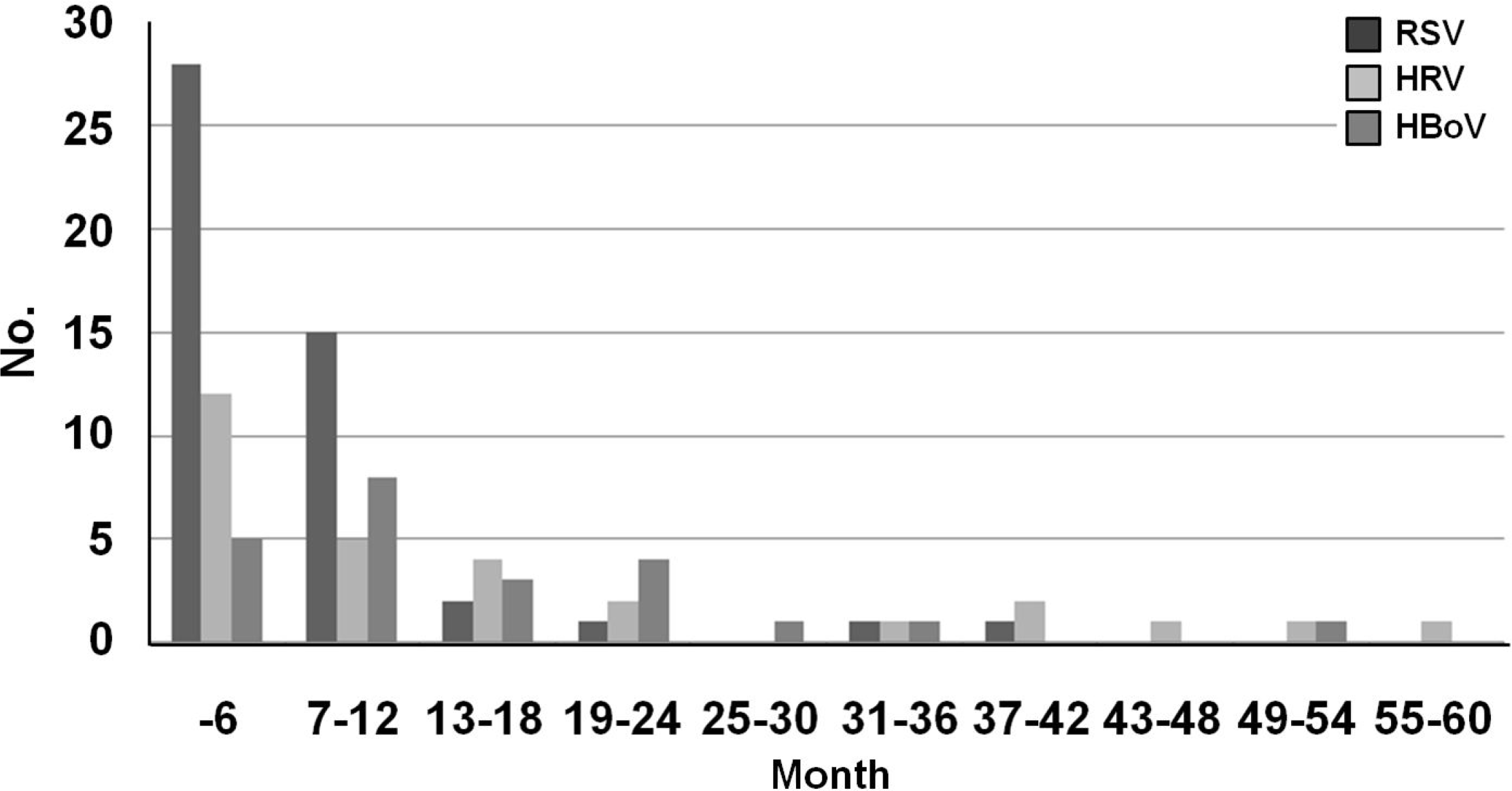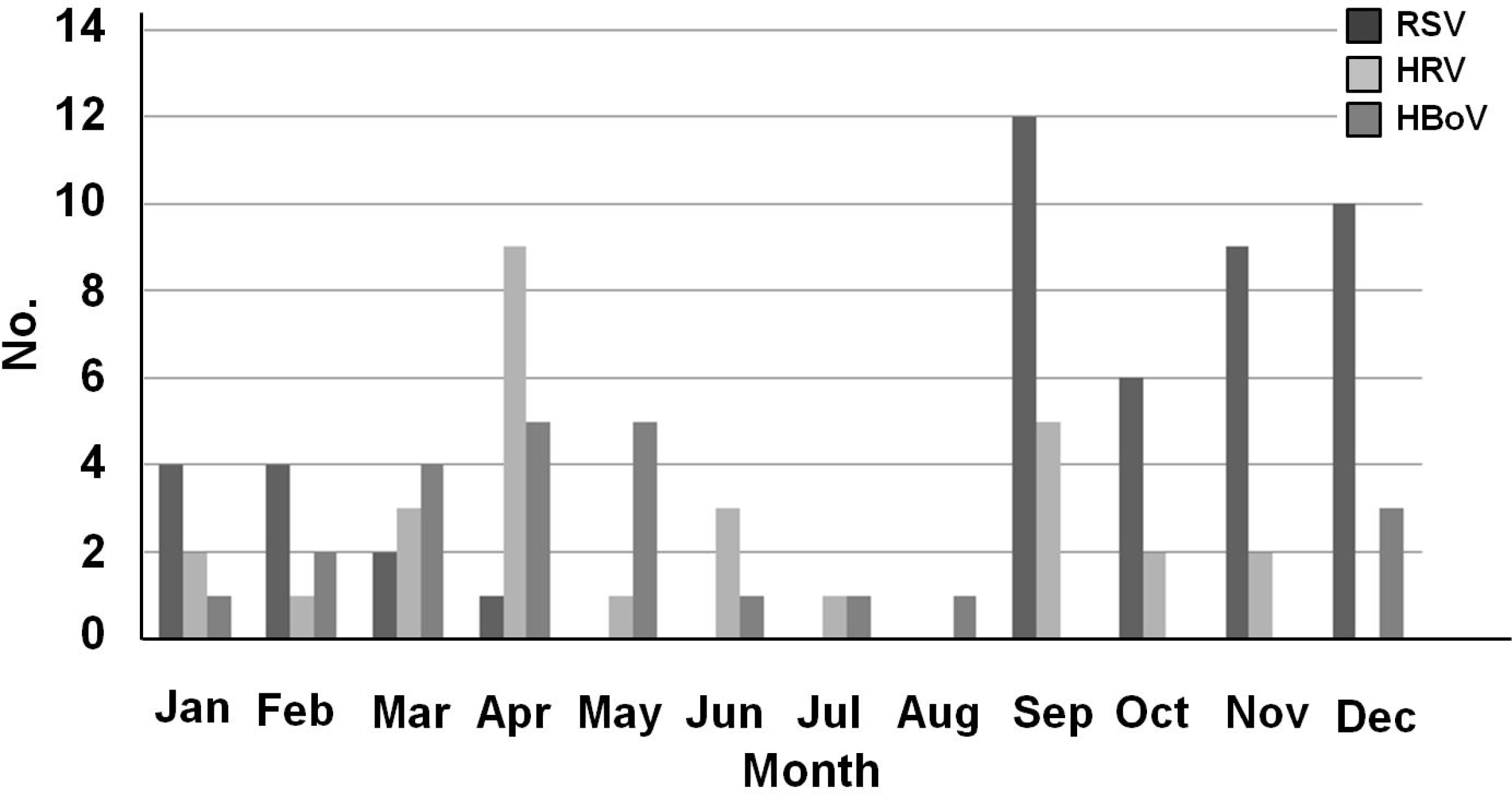Abstract
Purpose
The purpose of this study was to compare clinical manifestations of human bocavirus (hBoV), respiratory syncytial virus (RSV), and human rhinovirus (hRV) in children with acute wheezing.
Methods
We retrospectively investigated 549 virus-positive throat swabs obtained between January 2006 and December 2008 from pediatric inpatients with acute respiratory tract disease at Kwangju Christian Hospital. Among them, 109 patients, who had lower respiratory tract infections with wheezing, were enrolled in this study. The medical records of patients with positive results were reviewed for clinical data.
Results
The mean age of the patients with RSV was 7.15 months, 15.66 months in those with hRV, and 15.04 months in those with hBoV. The mean fever duration and frequency of patients with fever was 2.43 days and 47.9% for RSV, 2.86 days and 51.7% for hRV, and 3.75 days and 69.6% for hBoV. The frequency of patients with acute otitis media was 20.8% in the RSV, 20.7% in the hRV, and 13.0% in the hBoV groups. The frequency of lung infiltration on chest X-ray was 12.5% in the RSV, 20.7% in the hRV, and 47.8% in the hBoV groups.
Go to : 
References
1. Shay DK, Holman RC, Newman RD, Liu LL, Stout JW, Anderson LJ. Bronchiolitis-associated hospitalizations among US children, 1980–1996. JAMA. 1999; 282:1440–6.

2. Kim HW, Arrobio JO, Brandt CD, Jeffries BC, Pyles G, Reid JL, et al. Epidemiology of respiratory syncytial virus infection in Washington, D.C. I. Importance of the virus in different respiratory tract disease syndromes and temporal distribution of infection. Am J Epidemiol. 1973; 98:216–25.
3. Williams JV, Harris PA, Tollefson SJ, Halburnt-Rush LL, Pingsterhaus JM, Edwards KM, et al. Human metapneumovirus and lower respiratory tract disease in otherwise healthy infants and children. N Engl J Med. 2004; 350:443–50.

4. Miller EK, Lu X, Erdman DD, Poehling KA, Zhu Y, Griffin MR, et al. Rhinovirus-associated hospitalizations in young children. J Infect Dis. 2007; 195:773–81.

5. Kesebir D, Vazquez M, Weibel C, Shapiro ED, Ferguson D, Landry ML, et al. Human bocavi-rus infection in young children in the United States: molecular epidemiological profile and clinical characteristics of a newly emerging respiratory virus. J Infect Dis. 2006; 194:1276–82.

6. Heymann PW, Carper HT, Murphy DD, Platts-Mills TA, Patrie J, McLaughlin AP, et al. Viral infections in relation to age, atopy, and season of admission among children hospitalized for wheezing. J Allergy Clin Immunol. 2004; 114:239–47.

7. Khetsuriani N, Kazerouni NN, Erdman DD, Lu X, Redd SC, Anderson LJ, et al. Prevalence of viral respiratory tract infections in children with asthma. J Allergy Clin Immunol. 2007; 119:314–21.

8. Rakes GP, Arruda E, Ingram JM, Hoover GE, Zambrano JC, Hayden FG, et al. Rhinovirus and respiratory syncytial virus in wheezing children requiring emergency care. IgE and eosinophil analyses. Am J Respir Crit Care Med. 1999; 159:785–90.
9. Jartti T, Lehtinen P, Vuorinen T, Osterback R, van den Hoogen B, Osterhaus AD, et al. Respiratory picornaviruses and respiratory syncytial virus as causative agents of acute expiratory wheezing in children. Emerg Infect Dis. 2004; 10:1095–101.

10. Rosenthal LA, Avila PC, Heymann PW, Martin RJ, Miller EK, Papadopoulos NG, et al. Viral respiratory tract infections and asthma: the course ahead. J Allergy Clin Immunol. 2010; 125:1212–7.

11. Allander T, Jartti T, Gupta S, Niesters HG, Lehtinen P, Osterback R, et al. Human bocavirus and acute wheezing in children. Clin Infect Dis. 2007; 44:904–10.

12. Choi EH, Lee HJ, Kim SJ, Eun BW, Kim NH, Lee JA, et al. The association of newly identified respiratory viruses with lower respiratory tract infections in Korean children, 2000–2005. Clin Infect Dis. 2006; 43:585–92.

13. Bosis S, Esposito S, Niesters HG, Tremolati E, Pas S, Principi N, et al. Coronavirus HKU1 in an Italian preterm infant with bronchiolitis. J Clin Virol. 2007; 38:251–3.

14. Sloots TP, McErlean P, Speicher DJ, Arden KE, Nissen MD, Mackay IM. Evidence of human coronavirus HKU1 and human bocavirus in Australian children. J Clin Virol. 2006; 35:99–102.

15. Arden KE, McErlean P, Nissen MD, Sloots TP, Mackay IM. Frequent detection of human rhinoviruses, paramyxoviruses, coronaviruses, and bocavirus during acute respiratory tract infections. J Med Virol. 2006; 78:1232–40.

16. Arden KE, Nissen MD, Sloots TP, Mackay IM. New human coronavirus, HCoV-NL63, associated with severe lower respiratory tract disease in Australia. J Med Virol. 2005; 75:455–62.

17. Woo PC, Lau SK, Chu CM, Chan KH, Tsoi HW, Huang Y, et al. Characterization and complete genome sequence of a novel coronavirus, coronavirus HKU1, from patients with pneumonia. J Virol. 2005; 79:884–95.

18. Principi N, Esposito S, Bosis S. Human metapneumovirus and lower respiratory tract disease in children. N Engl J Med. 2004; 350:1788–90.

19. De Boeck K, Van der Aa N, Van Lierde S, Cor-beel L, Eeckels R. Respiratory syncytial virus bronchiolitis: a double-blind dexamethasone efficacy study. J Pediatr. 1997; 131:919–21.

20. Boogaard R, Hulsmann AR, van Veen L, Vaes-sen-Verberne AA, Yap YN, Sprij AJ, et al. Recombinant human deoxyribonuclease in infants with respiratory syncytial virus bronchiolitis. Chest. 2007; 131:788–95.

21. Denny FW, Collier AM, Henderson FW, Clyde WA Jr. The epidemiology of bronchiolitis. Pediatr Res. 1977; 11(3 Pt 2):234–6.
22. Glezen WP. Pathogenesis of bronchiolitis–epidemiologic considerations. Pediatr Res. 1977; 11(3 Pt 2):239–43.
23. Carlsen KH, Orstavik I, Halvorsen K. Viral infections of the respiratory tract in hospitalized children. A study from Oslo during a 90 months' period. Acta Paediatr Scand. 1983; 72:53–8.
24. Calvo C, García-García ML, Pozo F, Carvajal O, Pérez-Breña P, Casas I. Clinical characteristics of human bocavirus infections compared with other respiratory viruses in Spanish children. Pediatr Infect Dis J. 2008; 27:677–80.

25. Chung JY, Han TH, Kim SW, Kim CK, Hwang ES. Detection of viruses identified recently in children with acute wheezing. J Med Virol. 2007; 79:1238–43.

26. Söderlund-Venermo M, Lahtinen A, Jartti T, Hedman L, Kemppainen K, Lehtinen P, et al. Clinical assessment and improved diagnosis of bocavirus-induced wheezing in children, Finland. Emerg Infect Dis. 2009; 15:1423–30.

27. García-García ML, Calvo C, Falcón A, Pozo F, Pérez-Breña P, De Cea JM, et al. Role of emerging respiratory viruses in children with severe acute wheezing. Pediatr Pulmonol. 2010; 45:585–91.

Go to : 
 | Fig. 1.Age distribution of wheezing children infected with respiratory syncytial virus (RSV), human rhinovirus (HRV), human bocavirus (HBoV). |
 | Fig. 2.Seasonal distribution of wheezing children infected with respiratory syncytial virus (RSV), human rhinovirus (HRV), human bocavirus (HBoV). |
Table 1.
Symptom Scoring System (Reprinted from Boogaard R, Hulsmann AR, van Veen L, Vaessen-Verberne AA, Yap YN, Sprij AJ, et al. Chest 2007;131:788–95, with permission of American College of Chest Physicians) [20].
Table 2.
Viral Etiology of Respiratory Infection in 109 Children with Acute Wheezing during a 3-year Study Period
Table 3.
Characteristics of Children with Acute Wheezing Caused Solely by HBoV, Rhinovirus, and RSV
| No. of patient | Mean age (mo) | Fever | Mean | |||||
|---|---|---|---|---|---|---|---|---|
| n (%) | day | Duration of admission (day) | WBC count, / L μ | ESR, (mm/hr) | CRP, (mg/dL) | |||
| RSV | 48 | 7.15∗ | 23 (47.9) | 2.43 | 8.48 | 10,070 | 15.81 | 0.87 |
| HRV | 29 | 15.66 | 15 (51.7) | 2.73 | 9.23 | 11,525 | 20.33 | 1.53 |
| HBoV | 23 | 15.04 | 16 (69.6) | 3.75 | 9.09 | 13,800† | 25.78 | 0.72 |
Table 4.
Characteristics of Children with Acute Wheezing Caused Solely by HBoV, Rhinovirus, and RSV
| No. of patients with AOM (%) | Lung infiltration rate (%) | Severity score | Duration of wheezing (day) Mean | O2 inhalation rate (%) | |
|---|---|---|---|---|---|
| RSV | 10 (20.8) | 12.5 | 4.88 | 6.17‡ | 10.4 |
| HRV | 6 (20.7) | 20.7 | 4.17 | 4.59 | 10.3 |
| HBoV | 3 (13.0)∗ | 47.8† | 4.17 | 5.11 | 8.7 |




 PDF
PDF ePub
ePub Citation
Citation Print
Print


 XML Download
XML Download